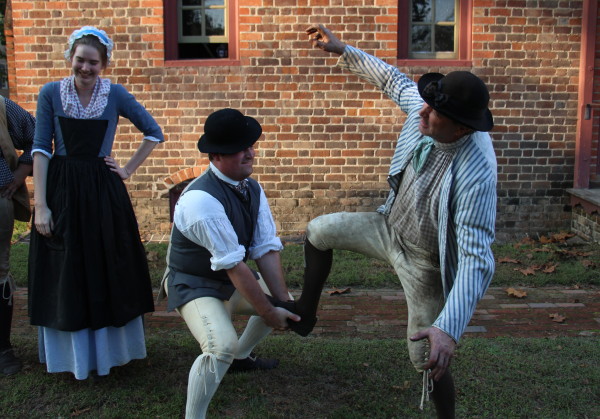 “Surprisingly supple.”
“Surprisingly supple.”
“Like a second skin.”
“They breathe pretty well and they’re really comfortable.”
I was more than a little surprised. A group of Colonial Williamsburg’s tradesmen— wheelwrights, blacksmiths, and tinsmiths—were talking about their new leather breeches with great affection.
Here I was thinking they were suffering for the sake of authenticity, but I was only half right.
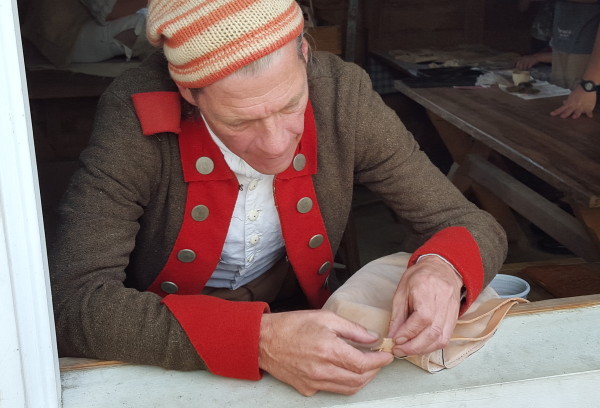 Military artificer Jay Howlett led the project to construct 11 pairs of leather breeches for tradesmen, a project made possible by generous gifts from donors. The Scott Eichelbaum Fund initiated the program and the program was extended until the end of the year through a gift from Fred Blystone and Louise Menges.
Military artificer Jay Howlett led the project to construct 11 pairs of leather breeches for tradesmen, a project made possible by generous gifts from donors. The Scott Eichelbaum Fund initiated the program and the program was extended until the end of the year through a gift from Fred Blystone and Louise Menges.
The beneficiaries of the work couldn’t be happier.
The tradesmen described the leather breeches as like wearing a favorite pair of jeans. But they also see it as another step towards greater authenticity.
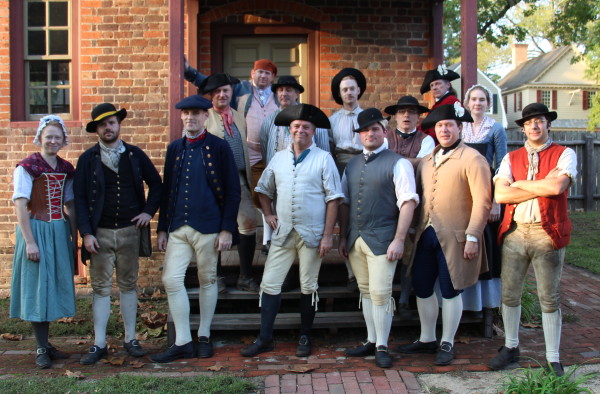 For sure, the leather breeches were authentic. They were ubiquitous in the 18th century. They were practical working clothes: flexible, durable, and even fashionable.
For sure, the leather breeches were authentic. They were ubiquitous in the 18th century. They were practical working clothes: flexible, durable, and even fashionable.
They ranged in quality from very poor up to breeches with fine stitching, elaborate pockets, and decoration. As apprentice tinsmith Joel Anderson put it, “Country gentlemen going out to survey their property weren’t going out in ruffles and silk.”
George Washington is even wearing leather in the famous Charles Willson Peale portrait on display at the DeWitt Wallace Gallery. How can you tell? Joel explains that blue and buff were the colors of Washington’s Fairfax militia, and became the model for the Continental Army. “But his leather breeches are a slightly different color of buff than his waistcoat, and the way it lays on his body, especially the ripples on the knee, denotes the way it’s made from leather rather than cloth.”
On the other end of the social spectrum, some runaway slave advertisements described fugitives as wearing leather breeches. One 1766 notice in the Virginia Gazette, for example, said Charles “had on when he went away a pair of old leather breeches a brown kersey jacket and an osnabrug shirt.” Such details offer insight into the minutiae of daily life.
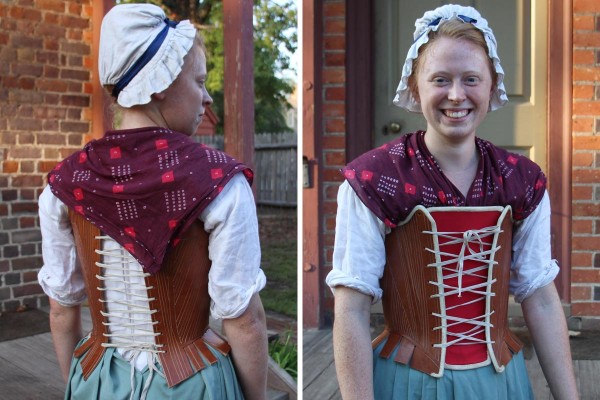 The project also included the production of leather stays (like the 18th century’s version of a corset) for apprentice blacksmith Aislinn Lewis. Tim Logue, and Jan Tilley, and Emma Cross joined Jay on the project (pictured left to right below), settling into the artificer’s shop behind the Armoury to complete the job.
The project also included the production of leather stays (like the 18th century’s version of a corset) for apprentice blacksmith Aislinn Lewis. Tim Logue, and Jan Tilley, and Emma Cross joined Jay on the project (pictured left to right below), settling into the artificer’s shop behind the Armoury to complete the job.
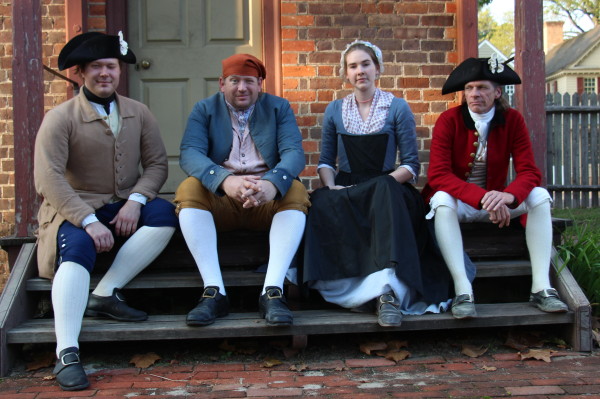
Work began on May 31 and ran through the summer, but the spark came much earlier. About 15 years ago, Jay was working as a saddler’s apprentice when he decided he wanted to make a pair of leather breeches for himself. How hard could it be, right?
But as he looked into it, it seemed no one he spoke to had really done the research to establish precisely how they were constructed 200 years ago. A grant from the Early American Industries Association gave him the opportunity to examine about three dozen pairs of the real thing “up close and personal” in various museum collections.
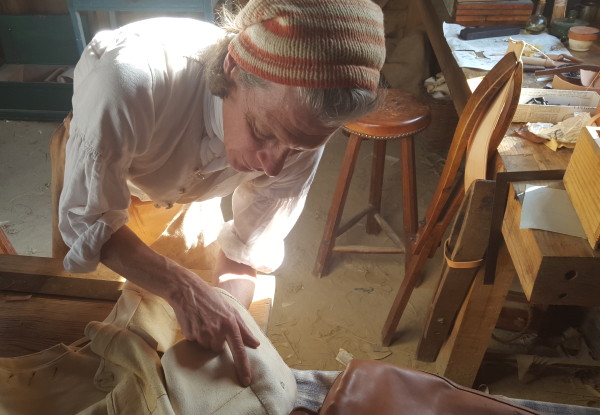 “I took tons of notes, made tons of drawings, and then came back and made tons of mistakes,” said Jay. What he discovered was a construction “utterly different” from the other breeches, which meant experimenting with different techniques for patterning and joining the pieces together. And they would have to be made extra tight to start to account for the way they would stretch out (also like jeans).
“I took tons of notes, made tons of drawings, and then came back and made tons of mistakes,” said Jay. What he discovered was a construction “utterly different” from the other breeches, which meant experimenting with different techniques for patterning and joining the pieces together. And they would have to be made extra tight to start to account for the way they would stretch out (also like jeans).
As you can see from the picture below, the breeches are not especially stain resistant. A good scrubbing gets out the worst of the dirt. A monthly cleaning is all they’re likely to get. But keeping the breeches spot-free is not as much of a concern as keeping them from smelling. Eventually, they expect to overdye the breeches in blue or black just to get rid of the grease marks and stains. But finding out how long it takes to get to that point is just one more part of this experiment.
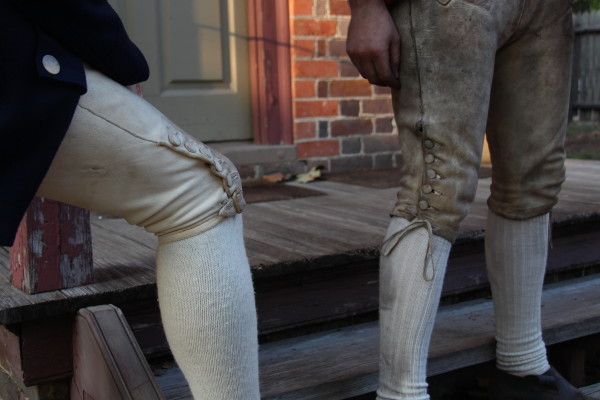 Down the road, hopefully we’ll be seeing more of the leather breeches. But for now, Jay and his shop are turning back to other work, which has recently included a bladder for bagpipes, portfolios, and cartridge boxes.
Down the road, hopefully we’ll be seeing more of the leather breeches. But for now, Jay and his shop are turning back to other work, which has recently included a bladder for bagpipes, portfolios, and cartridge boxes.

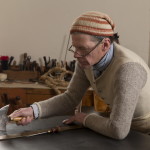
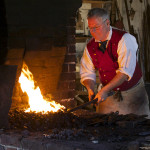

Thanks so much for the information about the leather colors, Jay.
Ruth
I’m very interested in the fact that you plan to overdye them in blue or black at some point. Is there documentation for this? It sounds like a great idea! Thanks.
Ruth,
Not sure where the blue is coming likely miscommunication, Edward Morris breeches maker here in Williamsburg advertises that he will make leather breeches “in all the colors of cloth”.However when you start looking at runaway advertisements the colors we see commonly are black,purple and olive in that order.Often when a color is stated the breeches are further described as old . JMH
Thanks for the information, Jay.
terrific article: I used to have a pair of buckskin breeches I had made, but I made them almost the same way I make cloth breeches, and I’d love to know how the author adapted his methods. Is there any chance of a follow-up detailing the methods, or, perhaps, a workshop in rhe future?
These are new times at Colonial Williamsburg so nothing is off the table.If workshops are what people want ,I am sure we will consider them provided there is interest.J
As director of the Early American Industries Association I was so pleased to know that the small research grant made to Jay Howlett in 2002 helped to make the design for the breeches possible!
A tip of the hat to EAIA and the work you do to keep this history alive!
John, without that grant in 2002 I never would have been able to get this off the ground,Today at Colonial Williamsburg there are staff development grants for projects like this ,but those came with our new President and did not exist back in ancient times when I started this work. Thank You , Jay
You didn’t mention Jan Tilley. Who used one of his weekend days each week and his vacation time this summer to volunteer at the shop. Jan has put in hundreds of volunteer hours with Jay as an Artificer over the past 6 years. He loves it!
Thank you for the correction , and my apologies for the oversight. I’ve edited the post and added a picture.
Thank you, Bill! That is very kind of you. Appreciate it!
My pleasure. Thank you for calling it to our attention.
Kate please see the “Meet The Artificer ” link above. Jan figures into that one too/J
Thank you Bill. This was a very interesting article and I know the Eichelbaums will be pleased too and thanks to all the donors. Sarah houghland
And speaking of generous supporters….I meant to add that this photo was just taken at noon today at our CW Associates donor society meeting. Both men were pilots…one Navy and one Airforce.
Thanks, Jay! I don’t remember seeing that one. It’s a great piece!